|
|
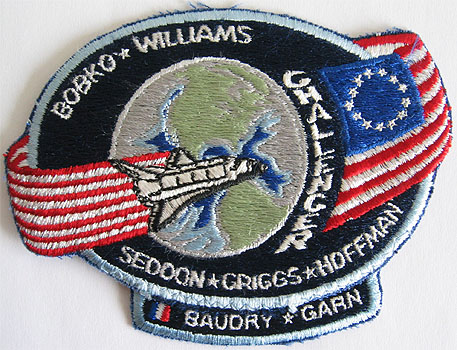
| Crew & Mission |
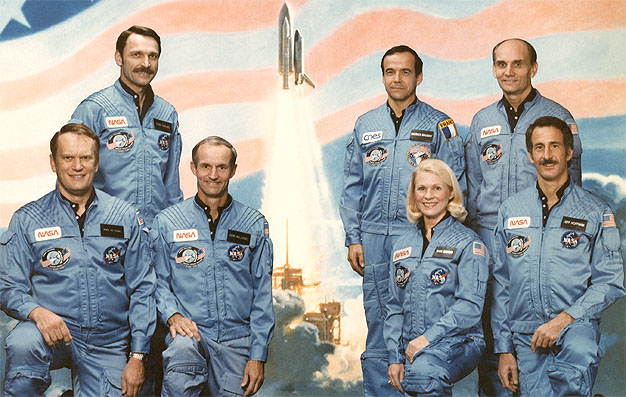
The crew members for STS-51E are Karol J. Bobko, Commander; Donald E. Williams, Pilot; M. Rhea Seddon, S. David Griggs, and Jeffrey A. Hoffman, Mission Specialists. U.S. Senator Jake Garn and Patrick Baudry from France are the Payload Specialist for this flight.
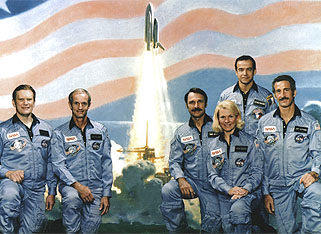
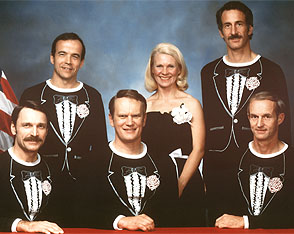
Problems with the TDRS-B satellite have resulted in a decision to cancel the March 7, 1985 flight of the Space Shuttle Challenger. It is expected that a delay of several weeks will be necessary to make modifications, so the TDRS-B satellite will be remanifasted. The Anik-C satellite from the STS-51E mission will be placed aboard the orbiter Discovery and will be deployed on Shuttle Mission STS-51D. The LDEF payload which was to have been retrieved on the STS-51D mission will remain in orbit. NASA plans to announce crew decisions and launch date late next week.
| Artwork |
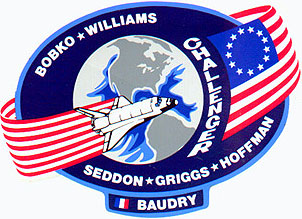
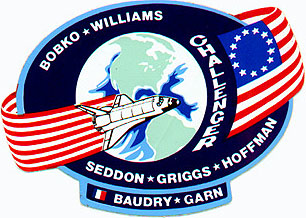
The dominant feature of the STS-51E emblem is an orbit formed by a colonial American flag and a Space Shuttle. The flag in orbit signifies the U.S. presence in space and pre-eminence in manned spaceflight. The original flag is used to symbolize a continuity of technical achievement and progress since colonial times. The French flag is displayed next to Baudry's name signifying the French Goverment participation in this flight. U.S. Senator Jake Garn is flying as a payload specialist.
History:
This particular patch has quite some history, as has its crew! In fact, four different versions were made. The most known and most available version of this patch is the fourth and final design, that of Shuttle flight STS-51D. The third version of the patch might also be known to some people, the difference being that this sports the name of Challenger and the name "Baudry" as well as a small French flag instead of the name "Walker". Some sources claim that this Challenger patch is the original version and that the Discovery version is based on it, which is not true. In fact, it is the other way around!
If all had gone according to plan, the Discovery patch and five members of the crew would already have flown in August 1984, on Discovery mission STS-41F. STS-41F was to be the second flight of Discovery and the 13th mission of the Shuttle Program. At the time the crew designed their patch, it was still tradition to incorporate the name of the orbiter ("Discovery") in the emblem, as well as some symbols refering to the mission number, with a certain amount of stars being the most popular way to do so. Up to then, this had not posed any problems, although mission STS-41B, the tenth Shuttle flight, had 11 stars on its patch - the original tenth mission (STS-10) had been cancelled in November 1983, too late to change the design.
This, however, did not withhold the (then) five member crew of STS-41F, led by Karol Bobko, to use a 1776 13-star Betsy Rose flag as the center piece of their patch, refering to the fact that they would fly the 13th Shuttle Mission. When STS-41D, the mission prior to STS-41F (STS-41E had also been cancelled) ran into problems on June the 26th, 1984, having an on-pad engine cut-off that required lengthy maintainance work, the payloads of this first Discovery flight were combined with that of the second, Bobko's STS-41F mission.
After mission 41F was cancelled and the Bobko crew was assigned to another flight, the 16th Shuttle mission, STS-51E. Although the symbolical 13-star flag did not make much sense anymore, the crew chose to hold on to their original mission patch design. Two changes had to made, however: first, STS-51E would be flown with the orbiter Challenger instead of Discovery and second, the name of French astronaut Patrick Baudry, who was already scheduled to fly on STS-51E, had to be incorporated in the patch design. Since there was no room for his name on the main body of the emblem, his name was put on a tab at the bottom of the patch. Since the patch had to be redesigned anyway to sport the name of Challenger, there was no need for the tab to be sewn on seperately - as had previously been done for late addition crew members Paul Scully-Power and Marc Garneau on STS-41G - so that the patch could be made out of one piece.
Soon, the patch manufacturers wished they had been wiser, because a seventh crewmember was assigned to the Bobko-team when the newly designed STS-51E patches had just been produced and were waiting to be distributed: senator Jake Garn. Because there already was a fixed tab to the patch, it was impossible to add Garn's name using a sewn on tab. The patch manufacturer chose to simply cut off the fixed Baudry tabs from the emblems and create the third version of the patch by adding a seperately sewn on tab with the names of both Baudry and Garn instead. This tab was not placed at the exact center of emblem, to keep Baudry's name in the same position. Because the Baudry-only patches had not yet been distributed, next to none of these escaped from the "Baudry amputation" and that is why this patch is extremely rare. Evidence from the surgery is however still visible in the earlier versions of the patch Baudy*Garn patch. By adding a tab to a patch with a sewn instead of an overlock border, there was no way to work around the dark blue background twill the patch had been embroidered to and a small part of the original Baudry tab was still visible. Later versions of the emblem - still using the same Baudry-only design - were therefore sewn on light blue twill and even had a minor reconstruction of the border. Some souvenir manufacturers chose another solution: they just added an overlock border to hide all evidence from the make-over.
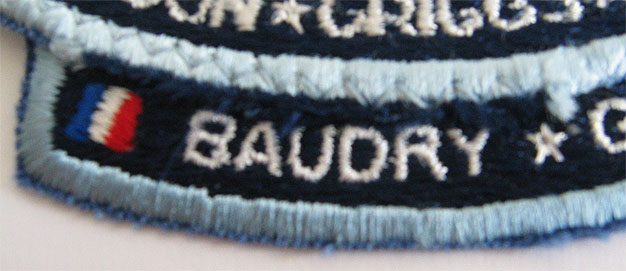
(if you look good you can see the original Baudry tab is still visible)
Ironically enough, all this trouble was to no avail, because on March 1, 1985, a month before lift-off and with the Shuttle and payload already at the launchpad, NASA decided to cancel mission 51E altogether because of problems with the payload. The Bobko-crew, who had already been bumped once, was granted a ride on the next Shuttle flight, STS-51D. The crew of that mission, led by Dan Brandenstein, got their turn to be bumped and were reassigned to mission STS-51G. One of the payload specialists of the Brandenstein crew, Charles Walker, remained on the 51D flight, however, because his equipment was already installed in the orbiter that would be used, Discovery. He swapped places with Patrick Baudry, who now would fly together with the Brandenstein crew on STS-51G. Replacing his name with that of Walker was now an easy task, thanks to the seperate tab. But not to the Challenger patches, since Bobko's crew would fly Discovery, as originally planned. It meant that the original STS-41F patch design (with the only difference that it had to be sewn on light blue twill instead of dark blue twill to enable the sewn-on tab) could be used after all with the newly made Garn/Walker tab, to form the fourth and final existing Bobko emblem and the one that was flown.
For NASA's public ralation office it was not too difficult to come up with a new meaning for the 13-star colonial flag and the 2 stars flanking Discovery: originally referring to the 13th mission, the flag was now "a link to history" and the two stars (standing for the 2nd flight of Discovery) now referred to both Discovery and its namesake, the research vessel it was named after.
So, if you ever wondered why STS-51D was the last flight in a very long time (Endeavour STS-49 was the next) to have the name of the orbiter on the patch... and why all Payload Specialists from then on found their names on seperate tabs: here's the answer!
| Collecting STS-51E |
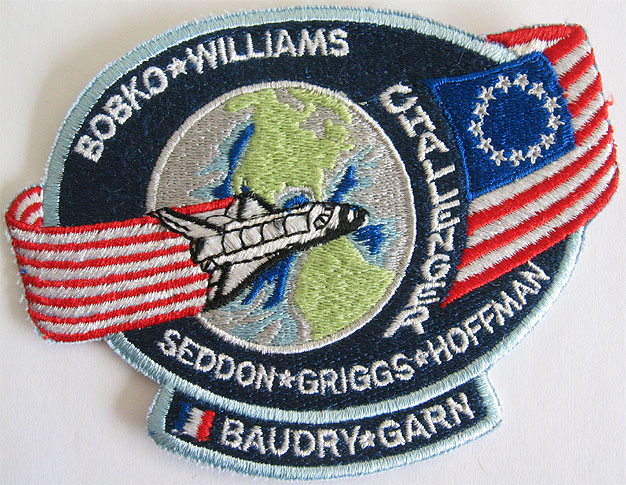
This is the best souvenir STS-51E patch we have seen to date, it came from Stewart Aviation. The patch has no seperate PS tab.